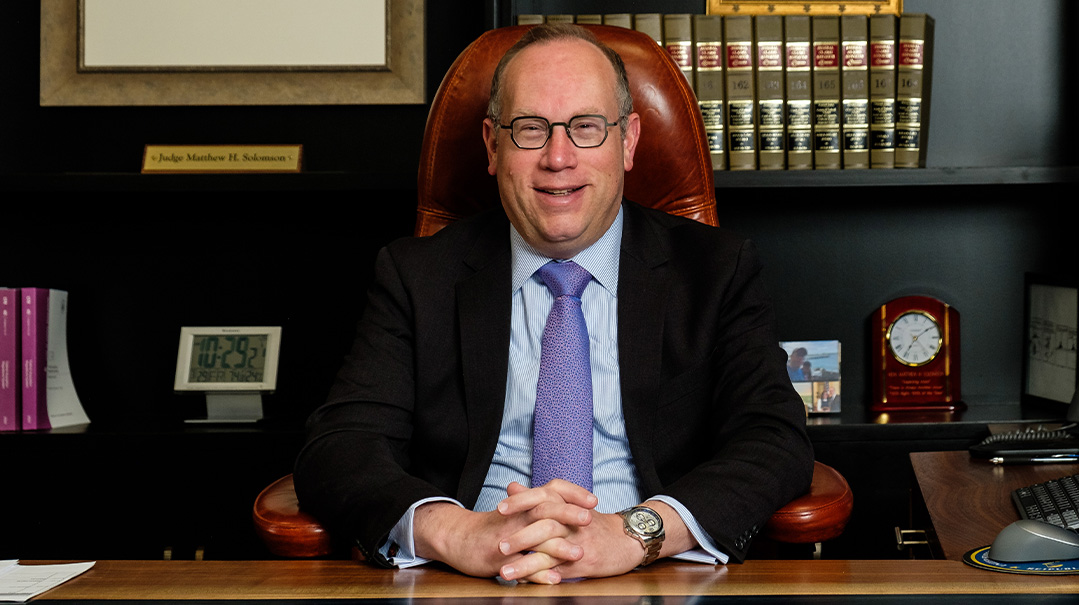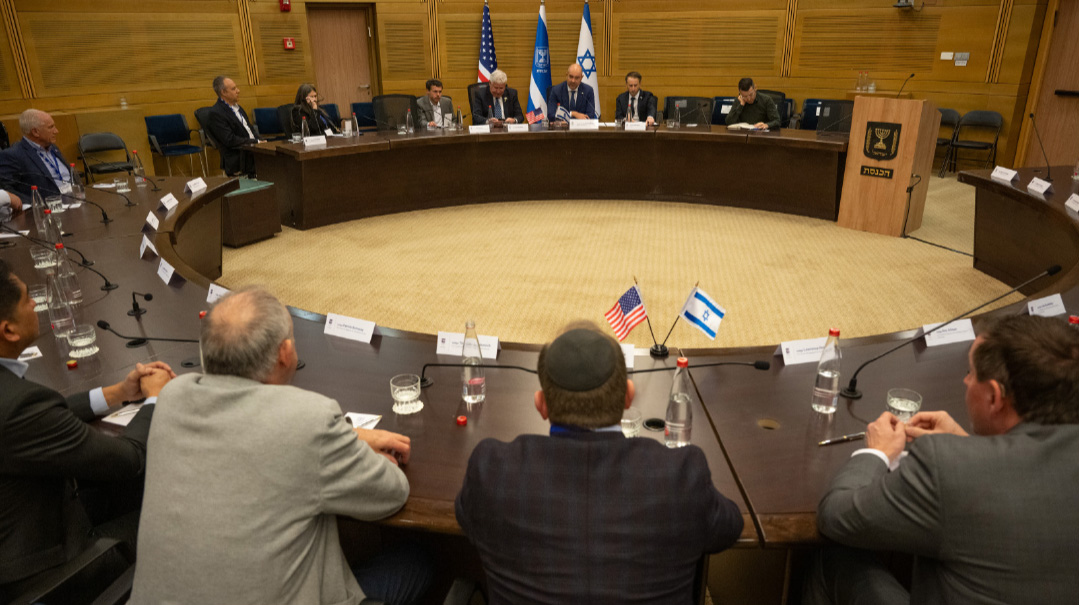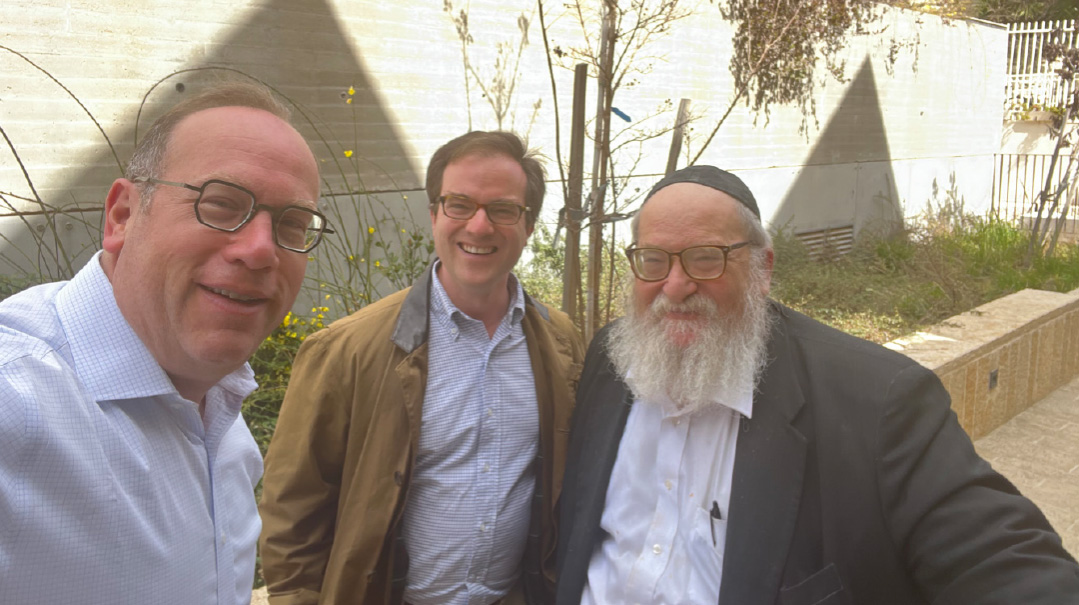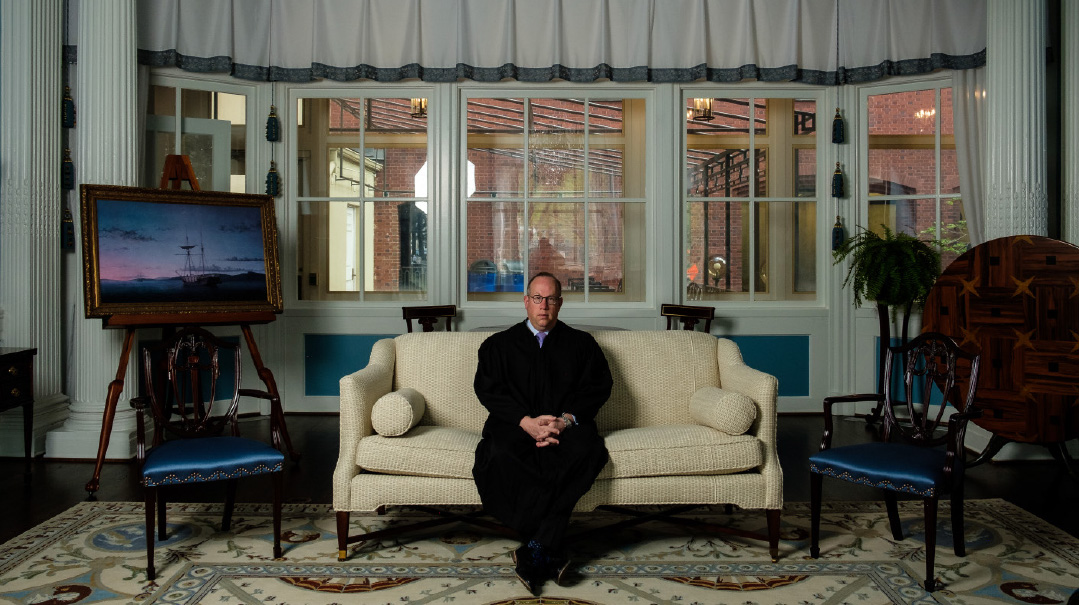Trial by Fire

Judge Matthew Solomson and friends bear witness to the unthinkable

Photos: Eli Greengart, World Jewish Congress
When Federal Claims Court Judge Matthew Solomson was first appointed to the bench, he was concerned about the ramifications of wearing his yarmulke: In such a high-profile position, with billions of dollars often at stake, might it be cause for a chillul Hashem? Today, though, he’s more interested in kiddush Hashem, having brought a group of federal judges to Israel to bear witness to an enemy’s unthinkable atrocities
Over the months since October 7, the tortured remnants of the Gaza border kibbutzim have become Exhibit A in Israel’s battle for the narrative about the justice of the ongoing war. Among the world leaders and influencers pilgrimaging to the site of horrors, though, few were as closely-connected to the cause of justice itself as the group who visited in recent days.
Headed by Federal Claims Court Judge Matthew Solomson, an Orthodox Jew, more than a dozen US federal judges converged on Israel last week to discuss the country’s legal system and military compliance with international law, but mostly, to see up-close the aftermath and fallout of the Hamas massacre and the IDF’s unprecedented and unenviable challenges in ferreting out a terror infrastructure among a civilian population.
Solomson, who organized the trip alongside Judges Roy Altman of the Southern District of Florida and Lee Rudofsky of the District of Arkansas, explained the importance of “bearing witness to the atrocities.”
Actually, the judges’ journey to Israel was on the table last summer, although not for the purpose it eventually served. Back then (if our memories can stretch just a bit beyond October 7), Israeli society was deeply divided over Prime Minister Binyamin Netanyahu’s push for judicial reform. This dispute had become the talk of legal circles worldwide, prompting Judge Solomson’s desire to grasp firsthand what was at stake. While the massacre of October 7 might have derailed the original plan, over time Judge Solomson realized there was a new and more urgent reason to travel to Israel.
“I said to myself, well, nobody’s worried about judicial reform anymore. But it seemed to me there was still a trip that should take place,” Judge Solomson tells Mishpacha. And so, the three judges began compiling a list. “We always hear a lot about bearing witness to the Holocaust, but somehow the level of denial in the world about what happened on October 7 in Southern Israel is, for me, almost impossible to fathom. There’s enough out there without having to see it in person. The idea that people could deny it or the extent of it is just shocking.”
Half of the 14 judges on the delegation were non-Jewish, including Patrick Bumatay and Lawrence VanDyke from the US Court of Appeals for the Ninth Circuit, and Sixth Circuit Judge Amul Thapar, but the response was unanimous.
“The judges were totally moved and affected by the realities of what happened on October 7,” says Sarah Friedman, Chief Marketing Officer of the World Jewish Congress, who sponsored the trip. “I think to the non-Jewish judges, the trip absolutely changed their perspective on the conflict. They were able to see that Hamas’ only objective is to kill and torture Jews and that October 7 was not about the liberation of the Palestinians or about the creation of a Palestinian State.”
The itinerary included the requisite visits to the Knesset and to several elder statesmen, but what surprised him was an invitation to meet with Supreme Court Justice Ofer Grosskopf and hold discussions with the IDF legal team.
“We were all impressed with the level of care that the IDF puts into attempting to minimize civilian casualties. We watched many video clips of IDF lawyers calling off strikes because there were people around. In our country, the lawyers give advice. In the IDF, the lawyers are literally given a veto and can stop an initiative or a strike.”
The first morning of the trip, when the judges were to be shown a private screening of the now-famous harrowing 47-minute video — filmed by Hamas terrorists with their own body cams — Judge Solomson got a call from his two daughters.
“Abba,” they said, “you already know the truth. They don’t need to persuade you. So why should your neshamah be exposed to this terrible stuff? Why do you need to see all that?”
Before the screening, the judges were given a preliminary presentation by a young female soldier who’d been on the team tasked with compiling the video. The soldier explained what they were about to see and then fielded questions from the group, when Judge Solomson spoke up.
“My two daughters, who look to be about your age, asked me not to watch it,” he told the young IDF spokeswoman, “but I’d like your opinion. Do you want me to watch it?” She said that, given his position of influence, it was important to watch.
Judge Solomson and the other 13 federal judges, many of them on the shortlist for the Supreme Court, emerged from the screening as different people. Perhaps the most significant impact was on Judge Solomson himself. While he’d already made headlines last October when he became the first judge to refuse to hire clerks who had expressed pro-Hamas sentiments, that 47-minute video was undoubtedly the starkest reality check of the trip (it was shown in Congress and in certain other US venues, but knowing those unspeakable atrocities happened just a few miles from where they were sitting took the experience to a different level).
“One of the judges is a former prosecutor and defense lawyer,” says Judge Solomson, “and he told me the night before that he was going to watch the entire thing and not flinch, because, he told me, ‘I’ve seen it all. I’ve seen so many dead bodies you can’t imagine. I don’t care. It’s all clinical to me.’ After the video, he was stunned. He said he’d never seen anything like that in his entire life.”
After the screening, says Judge Solomson, “You saw all these highly educated, very successful people kind of just go off into their own corners, like you can’t look at another person. It’s so overwhelming and you’re kind of embarrassed to have watched that stuff. It was three p.m. and I went up to a young chayal in the courtyard and asked, ‘Eifo Yerushalayim?’ He pointed, so I started davening Minchah. That was all I could do.”
Getting first-hand reports of military strategy just reinforced what the judges generally knew: that the allegations of “genocide” are patently absurd. “If the IDF wanted to kill people indiscriminately, it could do so. It has the potential. It has the air power. It doesn’t want to. That’s not the way the Jewish people behave,” Judge Solomson says. “The term ‘genocide’ was coined surrounding the Holocaust. And to turn it around and use it to describe what Jews are doing to defend themselves is disgusting. You know, there are Uighurs being persecuted in concentration camps by the Chinese. Nobody says a word. The Syrians killed Palestinians en masse. Nobody says a word. There are massacres in Africa. Nobody says a word. ISIS, you wait and see what the Russians will do about what ISIS just did. And you know, we know what the Russians did in Chechnya. Nobody says a word. But when Jews defend themselves, all of a sudden, it all becomes too much. It’s grotesque.”
Yet having met Israel’s legal teams, Judge Solomson is quite optimistic. “We met with the lawyers who are in charge of that defense, and they are phenomenal. They know their material and they know the facts. And, in the long run, what do we always say? ‘Sheker’ stands on one leg, right? There’s no way that these claims can end up standing against the nation of Israel. There’s no way.”

ON October 11, just four days after the Hamas massacre, Judge Matthew Solomson grabbed national headlines by becoming the first judge to announce that he wouldn’t hire clerks who had signed any advertisement or put their names on letters supporting the Hamas attack.
“I refuse to credential anyone who supports or even remotely sympathizes with terror in the form of a modern-day pogrom,” Judge Solomson wrote in his post. “This is not an unfair or hyperbolic Nazi comparison.” Judge Solomson’s comments came on the heels of law students signing statements viewed as blaming Israel for the Hamas attacks, prompting several law firms to withdraw job offers as a result.
In hindsight, he not only stands by his proclamation, he says he would do it again. Moreover, he claims to have received support even from the most unexpected quarters.
“Another judge from my court approached me and said, ‘Obviously, I wouldn’t accept someone who had signed that — It doesn’t even need to be clarified. If I get groups like these on a résumé, it goes right in the trash.’ ”
When asked if he faced any negative repercussions, Judge Solomson was unequivocal. “There was no blowback. There was some question about whether it was political in nature and therefore inappropriate for me to make such a statement, or perhaps unethical because we’re not allowed to engage in politics.”
Judge Solomson says that his stance is a moral one, and not an attempt to shout down political disagreements. “Since when is being opposed to a bloodthirsty terror organization a question of Democratic or Republican politics? It’s not a political issue to say that I’m against a group that sends death squads into Israel to kill Jews. So I just reject the contention that it’s political — and I received many messages from people who were happy that I put that message out there.”

M
atthew Hillel Solomson was born in 1974 in Hartford, Connecticut, although pinpointing his childhood to just one city would probably be inaccurate. Being the son of a military couple — his parents, Colonel Dr. Ronald and Mrs. Fern Solomson — meant that the family relocated numerous times during young Matthew’s childhood. He was raised in a “traditionally Jewish” household where kashrus was observed, and despite the challenges posed by constant moves, his parents ensured he grew up with a strong connection to Judaism.
“Depending on the city, I either attended a religious day school or a traditional school, or sometimes if we were living in a smaller community without a Jewish school, my parents would hire tutors for me. That’s what happened when we were in Hawaii.”
He remembers how, in Hawaii, they were living on an army base and his father built a succah in the front yard of his quarters on the base.
“A military police officer pulled over,” Judge Solomson remembers, “but my father was already a high-ranking officer, so, very politely, the military police officer said to him, ‘Sir, you know, you don’t have a permit. What are you building anyway?’ So my father explained to him what a succah was. Then the officer said, ‘Okay, I guess that’s fine.’ That’s how I grew up.”
Like many aspects of Judge Solomson’s life, his journey toward Orthodox life came from an unexpected direction. When it came time to apply to universities, his father insisted that he try for Brandeis University, where at least 50 percent of the students were Jewish at that time.
At Brandeis, Matthew was exposed to the Orthodox world. “I had many friends who identified as Modern Orthodox, and that generated a lot of questions for me,” he says. “I went to the Conservative rabbi on campus and just didn’t feel like my questions were getting answered. So I started asking my frum friends instead, and started going to the beis medrash to learn at night. And, I don’t know, I just started with a little bit of Gemara and a little bit of Mishnah Berurah, a little bit of Rashi… and then I met my wife there.”
The Solomsons settled in Silver Spring, MD, where Matthew would later continue his legal career at the University of Maryland, but before that, they decided to try living in Israel for a year so that Matthew could experience learning Torah in a real yeshivah. For the first six months, he was at Yeshiva Ohr Somayach, and during that year, he encountered Rabbi Aaron Lopiansky.
“We already owned a house in Silver Spring, and on one occasion, I asked Rav Aaron, ‘Do you think I could pull off just being in yeshivah in Silver Spring?’ And his advice was that I had to decide whether the year I took off was in order to spend time in the Holy Land or just to be immersed in learning. And if it was for learning, then I should be wherever I’m going to be learning best. We put our heads together, we came back, and I learned in the Yeshiva of Greater Washington where Rav Aaron has been ever since.”
After graduating with honors as a lawyer, Dr. Solomson clerked for Judge Francis M. Allegra of the US Court of Federal Claims (where he is now himself a judge).
“After law school, you apply to clerkships and you pray. I had an interview with Judge Allegra, who was Catholic and almost became a priest. I come in to the interview with him, and he’s got this massive picture of the Pope hanging on the wall. I say to myself, ‘Oh, well, we’re not going to have very much in common….’ But in the course of talking with me, he asks me what I like to do in my spare time. So I tell him, ‘Well, I’ve got two kids and I like to play tennis and I’m studying for my rabbinic ordination.’ And he says, ‘Oh, really? What denomination?’ And I say, ‘Orthodox.’ And he says, ‘Really? Well, I went to Catholic seminary in Cleveland, and it was right next to a very famous rabbinical school. Do you know its name?’ So I say, ‘Telz, but it’s spelled like Telshe.’ And he says, ‘Yeah, that’s the one! It was right next door to my seminary.’ We had a conversation about that, and he made me the offer the next day.”
Clerking was good for his résumé, and then Dr. Solomson pursued a successful private practice. Happily married with a growing family and a stable job, life seemed good enough to not run after changes. However, there were more surprises to come.
B
ecoming a judge isn’t something you can exactly plan for. At best, one can excel as a lawyer and then hope to receive a call from someone well-connected. According to Judge Solomson, one of the jokes in the legal world is that the best way to become a judge is to be the college roommate of a future senator or president.
Judge Solomson was appointed by then-President Donald Trump to the federal claims court (he was never Trump’s roommate). The claims court hears cases involving claims for money against the federal government, which was related to his practice.
“My law practice very much centered around the subject matter of the claims court — tax law, intellectual property law, all sorts of monetary claims against the government, including almost the entire range of government contracts issues. So anything having to do with government contracts can come to our court. And my practice was in government contracts and healthcare,” explains the judge. “At some point in my practice, I decided to write a book about the subject matter of the court. It was like a Shulchan Aruch about our court lobby.”
Apparently, within the legal world, the book made quite an impact. One day, while working for a major health care company, Judge Solomson received a call from a friend who worked for the Department of Justice. “Send me your résumé!” he said.
“No way,” said Judge Solomson. “I’ve got a great job, and I’m not looking to go back to the Department of Justice.” His friend placated him, reminding him that one of the functions of his department is to vet judges.
“So I said, ‘Yeah? For what court?’ And he said, ‘Well, I can’t tell you, but you may have written something about it….’ Soon afterward, I got a call from the White House, from President Trump’s legal office, to come interview. That was in April of 2017.”
It was also the second day of Pesach. “I remember saying to my wife, ‘We’re going to have to spend Yom Tov in Washington. I’ll daven Shacharis and then walk ten miles to the White House….’ And she said, ‘Are you crazy? Tell them you’ll do it after the holiday.’”
The future judge gathered his courage and asked the White House to postpone the meeting date, something they readily accepted.
But one question remained: Upon becoming a federal judge, should he hide the symbols representing him? Or, on the contrary, would he become the first federal judge with a yarmulke?

E
mbedded within Maryland’s Orthodox community, the Solomson family — members of the Ohr HaTorah congregation led by Rabbi Michoel Frank — flourished under the steadfast presence of Torah within their home, defining not only their children’s upbringing but Judge Solomson’s personal pursuits, as he dedicated himself to acquiring semichah and continuously refining his limud. Immersed in a kollel where he even conducts chaburos, he has cultivated close personal bonds with rabbinic figures such as Rabbi Lopiansky, Rabbi Mordechai Willig, and Rabbi Yitzchak Breitowitz.
Yet, the question of public appearance remained a quandary: to kippah or not to kippah?
Interestingly, Judge Solomson’s inquiry didn’t stem from a desire to conceal his identity. Rather, his primary concern was the concept of chillul Hashem. Seeking counsel from his close friend, Rabbi Binyamin Silver of Young Israel of Long Beach, he posed the pivotal question.
“The question originally was about when he was first nominated for the judgeship. Should he sit for the nomination wearing a yarmulke or not?” Rabbi Silver told Mishpacha. “He basically assumed that if he’d wear a yarmulke to the confirmation hearing, that would smooth the way for him to wear a yarmulke on the bench. And if he didn’t, it wouldn’t be right to be confirmed without a yarmulke and then suddenly show up day one as a federal judge wearing one. But it was never about, ‘Oh, am I comfortable or uncomfortable wearing a yarmulke?’ That was never the question. The question simply was, ‘I’m concerned that if I wear a yarmulke, and I have to make certain rulings — and those could be multi-billion-dollar rulings against major corporations suing the United States of America, generating a lot of nasty headlines… could there be a potential chillul Hashem. Are they going to pin it on me as a Jew?’ ”
Rabbi Silver addressed the question as both a spiritual leader and a close friend. “Look,” he told Judge Solomson, “there are many prominent Jews in the world, and many of them carry very prominent public roles. And by that logic, nobody should wear a yarmulke because we’re always going to be concerned that maybe something will go wrong and cause a chillul Hashem. So I would say the opposite: Demonstrate proudly who you are and what you stand for, and always do your best to make a kiddush Hashem.”
Today, Judge Solomson says he encourages others leaning in that direction to be visibly Orthodox. “I think we give each other strength when we see each other wearing a yarmulke in professional settings.”
S
ince returning from the Israel trip with his colleagues, Judge Solomson has taken it upon himself to deliver talks and organize gatherings for anyone interested in hearing the unvarnished truth about Israel and its war against Hamas. The day after we spoke, he was scheduled to speak at none other than Harvard University.
“The Jewish Legal Students Association at Harvard is actually reluctant to do Israel events,” the judge explained to me. “So I said to the person in charge, ‘Why don’t we have it co-sponsored by the Federalist Society [an academic society that hosts a variety of views through a conservative lens. Many of the judges appointed in the Trump administration were members of the Federal Society]?’ But then my Harvard contact told me that they already have an event going on that same time that they’re going to have me up tomorrow. So I asked, ‘Who’s the other judge that’s speaking for them?’ It happened to be none other than Judge Ryan Nelson... who had participated in our trip! I reached out to Judge Nelson and he told me, ‘I was going to speak on the First and Second Amendments. Forget that. Let’s do a talk about the Israel trip together!’ ”
A day after the talk with Judge Nelson at Harvard, I reached out to Judge Solomson to see how it went. “We had a friendly audience,” he messaged me, “but I heard from a Jewish student who said that her classmates still deny that Hamas killed any babies on October 7. Some people — especially those on college campuses — are living in an alternate reality.”
But he’s not giving up. “Judges still have a certain informal influence on society,” he says. “We have a voice that extends outside of the courtroom. And we have to confront those who try to bury the truth.”
(Originally featured in Mishpacha, Issue 1006)
Oops! We could not locate your form.







